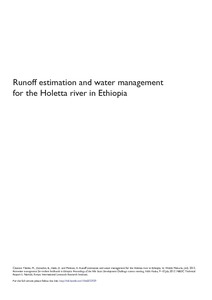Resource information
The hydrology of Holetta River and its seasonal variability is not fully studied. In addition to this, due to scarcity of the available surface water and increase in water demand for irrigation, the major users of the river are facing a challenge to allocate the available water. Therefore, the aim of this research was to investigate the water availability of Holetta River and to study the water management in the catchment. Soil and Water Assessment Tool (SWAT) modelled the rainfall runoff process of the catchment. Statistical (coefficient of determination [R2], Nash- Sutcliffe Efficiency Coefficient [NSE] and Index of Volumetric Fit [IVF]) and graphical methods used to evaluate the performance of SWAT model. The result showed that R2, NSE and IVF were 0.85, 0.84 and 102.8, respectively for monthly calibration and 0.73, 0.67 and 108.9, respectively, for monthly validation. These indicated that SWAT model performed well for simulation of the hydrology of the watershed. After modelling the rainfall runoff relation and studying the availability of water at the Holetta River, the water demand of the area assessed. CropWat model and the survey analysis performed to calculate the water demand in the area. The total water demand of all three major users was 0.313, 0.583, 1.004, 0.873 and 0.341 MCM from January to May, respectively. The available river flow from January to May obtained from the result of SWAT simulation. The average flow was 0.749, 0.419, 0.829, 0.623 and 0.471 MCM from January to May respectively. From the five months, the demand and the supply showed a gap during February, March and April with 0.59 MCM. Therefore, in order to solve this problem alternative source of water supply should be studied and integrated water management system should be implemented.



